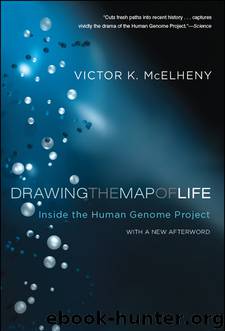Drawing the Map of Life by Victor K. McElheny

Author:Victor K. McElheny
Language: eng
Format: epub
ISBN: 9780465032600
Publisher: Basic Books
“Get Outside of Hypothesis-Limited Science”
Even before the draft human sequences of 2000, one of the first to plunge into human variation was David Altshuler, a physician specializing in endocrinology and internal medicine at Massachusetts General Hospital. The son of Alan Altshuler, who became transportation secretary of the Commonwealth of Massachusetts and dean of the Harvard Graduate School of Design, he received a bachelor of science degree from MIT in 1986, then went on to take a PhD at Harvard in 1993 and an MD at Harvard Medical School the next year. Joining the Whitehead Institute as a postdoc in the late 1990s, he became a founding member of the interdisciplinary Broad Institute of MIT and Harvard in 2003. Like others who followed the central tenets of genomics, he was dissatisfied with a medicine of “one size fits all.” To be truly useful, he thought, medical research must identify the actual mechanisms of disease and, according to a person’s particular genetic makeup, find and deliver specific treatments for those mechanisms. The inadequacy of a blunderbuss medicine aimed at symptoms, not causes, came up every day in the clinic. “Each time I write a prescription for a new patient,” he told a reporter in 2000, “I know it might not help at all and could do harm.”4
Although environment, including lifestyle, was, and would remain, crucial in treatment, Altshuler was profoundly pessimistic about exhorting patients to change their behavior. What fraction of people could be persuaded to eat less or walk more to avoid such rising scourges as obesity and diabetes? It was not the same problem as smoking, Altshuler recalled in 2006. “You don’t need to smoke to live, but you have to eat to live, so it’s quantitative as opposed to qualitative.” He continued, “If those things could be done, I think they could actually have huge impacts, so I’m very much in favor. However, as a clinician, having patients come to you and simply doing what is done today—just say, ‘You should lose some weight. Let me send you to a dietician, and, you know, and try and walk more,’ is completely ineffective. The studies have shown over and over again that it doesn’t work. . . . Diabetics in America aren’t controlled [with] available medicines and lifestyle modifications.” In such a situation, Altshuler was convinced, it was necessary to move beyond “wishful thinking” to admit that “we should invest in knowing more about the disease” so that it could be detected, prevented, and treated.
He had not come into genomics as “a genomics person.” Instead, “I’m interested in disease. I came to the conclusion that the best hope for disease was to find the genes. . . . The only way we were going to find the genes was to understand genetic variation.” Altshuler’s path to this involved the same attitude that brought about the genome project, a desire to “get outside of hypothesis-limited science,” in which a huge number of people pursued the same leads, the same “very small number of reductionist models.
Download
This site does not store any files on its server. We only index and link to content provided by other sites. Please contact the content providers to delete copyright contents if any and email us, we'll remove relevant links or contents immediately.
| Fossils | Game Theory |
| Genetics | Molecular Biology |
| Organic | Paleontology |
Sapiens: A Brief History of Humankind by Yuval Noah Harari(14221)
Sapiens by Yuval Noah Harari(5281)
Pale Blue Dot by Carl Sagan(4886)
Homo Deus: A Brief History of Tomorrow by Yuval Noah Harari(4801)
Livewired by David Eagleman(3663)
Origin Story: A Big History of Everything by David Christian(3633)
Brief Answers to the Big Questions by Stephen Hawking(3358)
Inferior by Angela Saini(3262)
Origin Story by David Christian(3133)
Signature in the Cell: DNA and the Evidence for Intelligent Design by Stephen C. Meyer(3057)
The Gene: An Intimate History by Siddhartha Mukherjee(3031)
The Evolution of Beauty by Richard O. Prum(2927)
Aliens by Jim Al-Khalili(2777)
How The Mind Works by Steven Pinker(2715)
A Short History of Nearly Everything by Bryson Bill(2617)
Sex at Dawn: The Prehistoric Origins of Modern Sexuality by Ryan Christopher(2472)
From Bacteria to Bach and Back by Daniel C. Dennett(2432)
Endless Forms Most Beautiful by Sean B. Carroll(2415)
Who We Are and How We Got Here by David Reich(2387)
